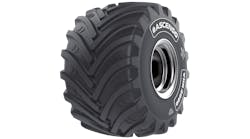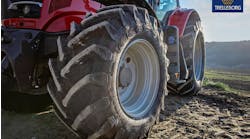Inflation, low commodity prices, political uncertainty, adverse weather and several other factors have combined to throw the United States ag tire market off-balance. Is a turnaround in the works?
Ag tire manufacturers discuss the current state of the market, what 2025 could bring and what ag tire dealers should continue to monitor in this MTD exclusive.
MTD: We hear the U.S. ag tire market is down. Is that true? If so, why?
THOM CLARK, president, Ascenso Tires North America: Yes, the U.S. agricultural tire market is down this year. This is mainly because farmers are earning less money due to high costs for things like labor and interest rates. Crop prices, especially for corn and soybeans, have also dropped, so farmers are cutting back on spending (on) equipment like tires. Additionally, with less government financial support, farmers are feeling more pressure to save where they can.
LAURENCE BENNETT, assistant vice president, global OHT, Apollo Tyres Ltd. (Vredestein): The U.S. OE ag tire market is experiencing a downturn this year.
However, Vredestein is currently seeing strong growth in this segment. As a relatively smaller player, we are less impacted by the broader business cycles affecting the market. Feedback from our customers is mixed, varying by region, but many are finding ways to grow alongside us, despite the challenging landscape.
ALAN ESKOW, vice president, BKT USA Inc.: The agricultural tire market in the U.S. has shown signs of slowing down this year. However, this is not a true net decline, as the situation presently seems rather stable although it is affected by several factors, starting with adverse weather conditions that have affected planting cycles in many areas, reducing the demand for tires. In addition, economic uncertainties related to the election year and geopolitical tensions have created a climate of hesitation among buyers, who prefer to postpone investment decisions, especially the more substantial ones. Factors such as rising interest rates and low commodity prices have further dampened investment in new farm equipment, including tires.
At BKT, we keep innovating to meet the needs of farmers and their demand for solutions focused on greater sustainability. Our technologies improve tire durability and performance, ensuring operational efficiency. Despite economic challenges, we are confident that these developments will lead to new growth opportunities by the end of 2024.
TONY ORLANDO, president, Bridgestone Integrated Agricultural Tire Business, Americas, Europe, Middle East, India and Africa: Yes, we’ve seen the U.S. ag tire market soften in 2024 due to the downturn in the farm economy. Crop prices have fallen steadily in the past two years. This, combined with high interest rates and increased input costs, is pressuring farmers’ net income potential, creating a reluctance to invest in new farm equipment. In addition, when cash was more abundant in 2022, we saw strong investments by farmers in new farm equipment and technologies. Tire dealers and OEMs built up a lot of inventory at the end of 2022, leading to strong sales for Firestone Ag, but lowering tire demand in 2023 and into this year. Many farmers who purchased new equipment then also don’t need to buy replacement tires yet.
The Association of Equipment Manufacturers (AEM) reports that the ag industry has seen lower investment in new farm equipment through August, as total U.S. tractor sales decreased 19% compared to 2023, while combine sales dropped almost 20%. There are some positives because U.S. sales of four-wheel-drive tractors increased nearly 5% compared to 2023 and just over 5% year-to-date, according to the AEM.
RYAN LOETHEN, president, North America, CEAT Specialty Tires: Farmers are traditionally cautious in their purchasing habits during election years, but this year it seems to be affecting new ag machinery sales and ag replacement tires even more so. Normally, you would see an inverse relationship between OE and aftermarket tire sales, but we’re seeing only a slight uptick in replacement tire sales, along with the sizable downtown in new equipment sales, which obviously impacts OE tire sales. An expected surge in replacement tire sales has not materialized this year.
Farmers typically hold on to their dollars in uncertain times and there’s a lot of uncertainty regarding federal farm subsidy bills and tax policy, as well as fuel costs and other expenses. Labor costs have been high and while input costs have moderated some, they are still high. Combine all of these factors with commodity pricing being low and you have some very cautious farmers right now.
There is definitely a flight to value in the farmer mindset. This represents an opportunity for companies like CEAT Specialty, which offers the latest in ag tire technologies with value level pricing.
YDO DOORNBOS, director, North America, GRI: The U.S. Department of Agriculture forecasts that 2024 will present significant financial challenges for American farmers, with net farm income projected to decline by 4.4% to $140 billion compared to the previous year. This decline, which marks a nearly 25% reduction in farm income over two years, is primarily attributed to escalating costs for labor, interest and taxes, coupled with a reduction in government support.
These factors collectively strain farm profitability — underscoring the ongoing economic difficulties faced by the agricultural sector — and have resulted in a reduction of ag tire demand in both the OE market and aftermarket. There have been several other issues to this downturn: lack of advertising, supply chain issues, change of farms and crops and changes in tire designs.
GREG GILLAND, vice president of agricultural segment, Maxam Tire North America: The total U.S. ag market is flat to last year, when we saw a decrease of the total market in both radial and bias tire demand. The shift this year is an increase in radial demand and (a) very small increment in bias. In essence, the market is readjusting from the historical market peak in 2022.
As crop prices continue to rebalance well below the 2022 market peaks — coupled with increased operational costs like fuel, fertilizer, seeds and interest rates (inflation) — farmers are choosing to replace tires rather than machinery. This trend has had a two-part effect on the tire market. OE sales have slowed down from market peak in 2022 and radial tire demand, especially for sizes linked to ag production machinery above 100 horsepower (hp), has increased. The market that has been negatively impacted is the utility or support equipment (less than 100 hp tractors) in the short term, as farmers and producers are focusing their limited resources (on) their food or revenue generating production machinery.
JESSE BURDETTE, Beyond Road market intelligence manager, Michelin North America Inc.: The U.S. agriculture tire market is down this year across the industry primarily due to lowering commodity prices and revenue pressure on farmers. Michelin believes farmers are conserving capital by delaying as long as possible all discretionary spending through the current season.
FABIO FAVINI, head of sales, marketing and supply chain, U.S.A. and Canada, Prometeon: In comparison to last year, yes. At the beginning of the year, we were optimistic about the growth trends. However, the market since the mid-year period is facing some stagnation. Loss in profits, caused mostly by high inflation in the agricultural market, have led to a loss of income and purchasing power for farmers across the country, resulting in lower investment opportunities for tractor parts, including tires.
JAMES CROUCH, national segment manager — agriculture and forestry, Yokohama Off-Highway Tires America Inc.: The U.S. ag tire market is down this year. High interest rates and low commodity prices early in the year, coupled with the lack of a farm bill and the uncertainty that often occurs in election years, led to low farm incomes and declining demand for farm machinery. As a result, OEM tire sales were off. That left some room for replacement tire sales as farmers kept older equipment in the field, but inventory in the tire sales channel filled a significant enough part of that demand to keep new tire sales soft.
ANDREA MASELLA, commercial director, agricultural, North America, Yokohama TWS: Within North America, yes, the market is down, especially within the OEM segment, due to low commodity pricing and increased input cost for producers. High interest rates are also impacting new equipment purchases and driving increased focus on inventory levels for tire distributors.
MTD: Can you describe the state of the U.S. ag tire market? What is replacement demand like right now?
CLARK (Ascenso): In 2024, the U.S. ag replacement tire market is steady, mainly because farmers need to keep up with tire maintenance, even as new equipment sales slow down. Despite tough economic times and income ups and downs, investing in tire replacements still pays off by keeping equipment running efficiently and reducing fuel consumption. Newer tech, like durable radial tires, reduces soil compaction and boosts yields, making replacements essential for staying productive. So while the market isn’t booming, these tires are crucial for efficient farm operations.
BENNETT (Apollo/Vredestein): Currently, there is a noticeable shift among customers seeking alternatives to established brands. Some are opting for budget-friendly options, while others are choosing high-quality alternatives. Budget options help keep initial costs low, but many customers are increasingly recognizing that investing in high-quality tires, like Vredestein, offers the lowest cost per hour and a better return on investment. These customers understand that superior tires enhance traction, improve fuel efficiency and extend lifespan, ultimately reducing the total cost of ownership.
ESKOW (BKT): The agricultural tire market has shown a drop compared to the previous year, although the extent of this decline remains somewhat uncertain. Several factors have contributed to this situation. The high cost of seeds and fertilizers has increased farmers’ expenses, while lower prices for raw materials — such as corn, soybeans and cotton — have squeezed profit margins, making it difficult for farmers to invest in new equipment and components, including tires.
The OEM channel, in particular, is experiencing hardship. Companies are cutting their workforce and reducing production as a result of the falling demand for tires. Despite the unfavorable environment, replacement tire sales are holding up well, thanks to a plentiful harvest in several areas of the U.S. However, it is unlikely that a real increase in the demand for replacement tires will occur before early 2025, once the harvest has been completed and farmers’ availability of resources are assessed.
ORLANDO (Bridgestone): Used farm equipment inventories are up, both on dealer lots and at auction. Used equipment prices are coming down, which is a good sign for used equipment sales. This is encouraging for replacement channel demand because farmers typically retool recently bought, used tractors with new tires to better fit their cropping systems. We’re also approaching the end of the year, when farmers make large purchases to offset income as part of their tax management strategies. There is an opportunity for replacement sales to improve later this year and into 2025. We’re optimistic aftermarket tire sales will end the year up or at least even with 2023.
Despite farmers’ current caution and reluctance to buy, manufacturers supporting the U.S. ag tire market continue to invest in developing new technology because farmers continue to seek better ways to farm. Farmers invest in products that help them protect soil health to improve crop yields. Farmers are also interested in greater efficiency to save time and reduce the cost of inputs, such as fuel.
To be sure we have the products they need, Firestone is anticipating agriculture’s future challenges. Our expert engineering team at the Firestone Farm Test Center in Ohio collaborates closely with Bridgestone’s global research and development network. Together, we are developing cutting-edge solutions designed to enhance overall equipment productivity and tire durability in the agriculture industry.
DOORNBOS (GRI): Despite the anticipated inverse relationship between OE tire sales and aftermarket replacement sales, the U.S. farm tire market has exhibited a deviation from this trend in 2024. While a decline in OE sales is typically associated with a surge in replacement tire demand, the observed data reveals a modest increase in replacement sales. This discrepancy suggests that farmers are currently exhibiting a reluctance to invest in new replacement tires, possibly due to economic concerns or other factors influencing their purchasing behavior. Moreover, after-sales have experienced a less severe decline compared to OE sales. One contributing factor to this is the strategic decision of farmers to extend the lifespan of their existing agricultural equipment. Given the challenging economic conditions in the agricultural sector, many farmers are opting to invest in new tires to prolong the operational life of their current machinery rather than incurring the expense of purchasing new equipment.
GILLAND (Maxam): The ag tire market remains positive for the 100-plus hp machinery, with below-100 hp significantly slower than the previous three years. The replacement channel can win the day only by having tires on the shelf when farmers knock on the door. Farmers and producers are making spot decisions as they measure their profits versus yields in progress in order to invest their meager results as effectively as possible as they close full-year 2024 and prepare for 2025.
BURDETTE (Michelin): Michelin believes the replacement market has been dually impacted this year. First, it is impacted by a wave of OE equipment that was sold over the last three to four years. All of this new equipment is currently operating in the field and has not yet entered the demand cycle for replacement tires. Secondly, revenue concerns with farmers for this current harvest season are prompting them to delay necessary spending.
FAVINI (Prometeon): The replacement channel remained sizeable in 2024. However, high dealer competition and high inventory stock is causing a potential headache for many tire manufacturers. The risk is that these issues will lead to a fierce pricing battle among manufacturers to maintain their respective market shares. Dealers would be facing a similar pricing battle scenario to maintain healthy sales volumes in their region and as a consequence, this can mean a decrease in overall margins, and less opportunities for investment.
CROUCH (Yokohama Off-Highway): When farmers aren’t buying new machinery, they’re more likely to invest in replacement tires to keep their existing equipment running. The U.S. replacement farm tire channel demand is picking up as inventories are selling off and the cost of money is dropping, but it’s still a soft year for demand overall.
MASELLA (Yokohama TWS): The replacement channel is slightly down due to significant new equipment sales in the market over the last few years and considering the long life of agricultural tires, this lowers the immediate need of replacement tires.
MTD: What will the U.S. ag tire market look like in 2025?
CLARK (Ascenso): The U.S. ag tire market is set for modest growth, with steady demand for replacement tires as many farmers focus on keeping their current equipment running well, instead of buying new machines. While many are holding off on buying new machinery, quality replacement tires are keeping farms efficient and productive.
BENNETT (Apollo/Vredestein): We anticipate a favorable market in 2025, particularly as investments in new equipment have decreased over the past two years. This typically leads to extended use of existing equipment, driving increased demand in the replacement tire market. We expect our Vredestein ag tires to grow significantly faster than the overall market during this period.
ESKOW (BKT): We expect the farm tire market in the United States to remain stable in 2025. The main variable that will influence this scenario will be the price of raw materials. If prices continue to fall due to reduced exports, many farmers will have less cash on hand, making it more difficult to purchase new equipment and components, including tires. In addition, if this year’s crops are not profitable, obtaining financing for seeds and fertilizer will become an even greater challenge for farmers. The costs of agricultural inputs, such as fertilizer and fuel, are likely to remain high, continuing to put pressure on farmers’ product margins. In particular, conflicts in the Middle East might cause fuel prices to rise sharply, pushing up farm operating costs even further. This scenario will keep uncertainty high and further limit investment in new equipment, including tires.
Conversations with OEMs confirm that the market is not expected to improve significantly before 2026. The current market environment would suggest that economic challenges will persist for at least another year, negatively affecting both the demand for new machinery and new tires.
ORLANDO (Bridgestone): We expect the U.S. ag tire market to still be soft into at least the first six months of 2025 due to current commodity prices, interest rates and the fact farmers are not buying new equipment. However, used equipment supplies and prices are favorable for farmers who want to upgrade. Many farmers will retool the used equipment they buy and tires do not have an infinite lifespan, so replacement sales will happen as needed. In addition, agriculture is cyclical. There are many domestic and global factors affecting the agricultural economy. We’re optimistic that global demand for agricultural commodities will improve, and economic conditions will level out going into the second half of 2025.
LOETHEN (CEAT): The equipment in the field is still relatively new, so we anticipate OE ag tire sales to remain rather weak for most of 2025. This should have a positive impact on replacement tire sales, which should also benefit from increased farmer income due to commodity pricing bottoming out.
We’re optimistic that the replacement tire market will be improved in 2025, but farmers will remain cautious on their expenditures. We’re seeing a trend of ag tire dealers going to market with a few select brands in the different tiers to benefit from the ease of dealing with fewer tire suppliers and taking advantage of manufacturer buying programs and volume pricing. This was not the case awhile back, when there was short tire supply and dealers had to get tires anywhere they could.
DOORNBOS (GRI): In 2025, we do not expect OE to show growth and dealer feedback is confirming that they are cautious in ordering for spring due to over-ordering last year, as nobody was expecting such a difficult market in 2024. Opportunities are there for GRI, which is producing high-performing tires at an accessible price point, thus offering an attractive value proposition. The tier two aftermarket market is growing at the expense of the premium manufacturers.
GILLAND (Maxam): It is too early to predict what the market will look like by the first quarter of 2025, but the expectation is that the market will probably remain similar to 2024 if crop prices remain about the same and with radial tire demand continuing to increase yearly. As OE platforms continue to increase in both horsepower and gross vehicle weight to meet the global food demand — as it’s inevitable with a growing population — driving larger radial tires that deliver the necessary productivity (is expected). For the U.S. market, the election’s short- term impact, coupled with market yields, will heavily influence cost parameters of farm operations. This can either positively or negatively affect their purchasing decisions in 2025.
BURDETTE (Michelin): Michelin expects replacement demand to rebound in 2025. While farmers may be moving purchases forward this season, current tires will begin to enter their end-of-life stage, eventually necessitating the need to replace older and worn tires in order to continue operations.
FAVINI (Prometeon): The market is expected to see gradual recovery in 2025, contingent on economic stability and improved farmer income levels. The industry will remain competitive and farmers have a lot of options. In 2025, the market preference will steer more towards high technology and performance.
CROUCH (Yokohama Off-Highway): Ag markets are always cyclical, but it’s hard to guess when the current cycle will turn upwards. I think we will see the ag tire market pick up in 2025. Grain stocks will ultimately shrink, which will strengthen commodity prices. Interest rates are dropping.
MASELLA (Yokohama TWS): Within the OEM channel, the expectation is for market demand to still be soft throughout the first half of 2025 and then a slow recovery. Within the replacement channel, we see an improvement driven by lower equipment sales over the last 18 months and improved inventory levels of our partners.
MTD: Are there any trends that ag tire dealers should look out for?
CLARK (Ascenso): Ag tire dealers should keep an eye on the rising demand for advanced tires like very-high flexion (VF) tires. VF tires can carry heavier loads at lower pressures, which helps protect soil and saves fuel — great for farms with heavy-use equipment.
Stocking VF tires can be a good move, as more farmers want options that make their equipment tougher and better for the land.
BENNETT (Apollo/Vredestein): There are several key trends in the ag tire sector. Notably, VF tires, which can operate at substantially lower inflation pressures, are becoming more accessible, particularly in both tractor and flotation tire categories. Additionally, radial flotation tires are gaining popularity as customers recognize their benefits for soil health, productivity and fuel savings.
ESKOW (BKT): From our viewpoint, agricultural tire dealers should pay attention to several emerging trends in the industry. A major one is the increased use of more powerful and heavier tractors often equipped with equally heavy implements. This has a direct impact on the choice of tires, which must be able to support this more impressive machinery and carry greater loads without compromising performance.
VF tires are becoming increasingly popular, especially for use on tractors. Their ability to operate at lower pressures, reducing soil compaction, is particularly beneficial to farmers. Moreover, IF and VF tires for agricultural implements are also gaining ground, given the increasing mass of implements and the speed at which they are transported on roads.
Finally, the market is currently witnessing the introduction of many new tire sizes, driven by both OEM demands and mainstream demand. As a result, retailers have to manage their stocks more carefully, making sure that they meet customer needs and respond promptly to the demands of a rapidly evolving market.
ORLANDO (Bridgestone): We see farmers look to trusted resources for help making the best decisions possible. They want well-informed advisors who know the features and benefits products offer. Ag tire dealers can be the farmer’s trusted advisor for tire decisions by investing in education and training about the products they sell. At Firestone, we offer training through Firestone University as part of our dealer certification program and field clinics to help dealers educate customers.
Another trend is farms continuing to get larger. With this, farmers are traveling greater distances on the road with their equipment. They want and need tires that have greater wear life and provide a smooth ride on the road, but still deliver great traction and soil-health benefits in the field. We encourage our dealers to keep this in mind when helping customers select tires for high-horsepower tractors.
We’ve also seen a lot of farmers adding aftermarket equipment like saddle tanks to apply liquid fertilizer and other crop inputs. Single standard row crop radials that come on the tractor often aren’t built to carry the extra weight. This causes sidewall strain and eventually premature failure. To help farmers avoid issues like this, we’ve been actively working to educate our dealers about overloading (and) how to avoid overloading by choosing the right tires, properly (setting) up their tractors and (inflating) tires appropriately for the work being done. It’s part of our effort to support our dealers and help farmers get the most from their tire investment.
LOETHEN (CEAT): It’s more important than ever for dealer personnel to be up on the latest tire technologies and be able to communicate those in a relatable manner to their farmer customers. Farm tires have evolved tremendously in technology as tractors and other farm machinery have progressed. As tractors have grown larger and more powerful, tires have been engineered to handle greater loads. For example, dealers need to communicate the benefits of VF/IF tires, such as minimizing soil compaction and longer tread wear, on this heavier machinery.
Advances in tread design have improved traction and durability. Newer tread patterns are optimized for various soil conditions and can offer better grip and reduced slippage, which enhances efficiency in fieldwork.
Dealers should communicate how advances in tire compounds, designs and construction benefit their customers in areas such as stubble damage. Corn stalks today are much tougher due to genetic engineering, so companies like CEAT have devoted tremendous R&D resources to develop puncture resistance sidewalls.
With farmers working more and more fields separated by paved roads, roadability is an increasingly important attribute. Farmers want a smooth and stable ride from their tires on the road, so they are better-rested when they arrive at that next field. Farmers will pay attention to details from their dealers on how a particular tire performs on paved roads.
GILLAND (Maxam): The ongoing trend in 2024 and will probably extend to 2025 is related to opportunity sales. When farmers or producers are ready to buy, the dealers and distributors need to have inventory on hand (less than week) to meet the sale. Maxam’s recommendation is to manage their sellable inventory and take advantage of programs to both plan and schedule replacement stocks. This meets the market need in a timely manner for the first half of 2025.
The past 12 months have been the most challenging for the ag market beyond the container and shipping freight crisis of 2021. If economic and political conditions do not change for 2025, we expect more of the same working conditions as experienced in 2024. Should conditions improve in early-2025 related to previous year crop yields, commodity prices improve or input costs decrease, then pent-up demand will increase additional sales in both the 100- plus hp and below-100 hp market machinery segments.
BURDETTE (Michelin): Weather can always play a role in the timing of tire purchases. The agriculture replacement market is very seasonal with the start of spring planting season, as well as around harvest season. Cold weather and rain can delay that activity by a few weeks to a month while warm weather and dry conditions can bring it forward. Michelin advises making sure farmers have the right inventory within the right time frame — a consideration which is crucial to keeping farmers moving.
FAVINI (Prometeon): Dealers should monitor the rising demand for tires supporting more efficient and heavier machinery. The market wants versatile and sustainable products and expects better performance in traction, self-cleaning, soil compaction and fuel efficiency.
CROUCH (Yokohama Off-Highway): At Yokohama Off-Highway Tires, we’re focusing primarily on the value that great tires can deliver to farm equipment. Competing on price in a soft market is a race to the bottom.
MASELLA (Yokohama TWS): Farm consolidations continue — driving needs (for) larger equipment and larger tires to improve more efficiencies and productivity. New technologies, such as VF construction, tire inflation systems and extra-large sizes, continue to gain popularity in the marketplace. Sustainability within all aspects of product and farming continue to drive innovations. Lack of labor is expanding the need for more autonomous equipment. The fundamentals of the industry are solid and the future remains very bright as the U.S. continues to be high producer of agricultural products to not only feed our country, but the rest of the world.





